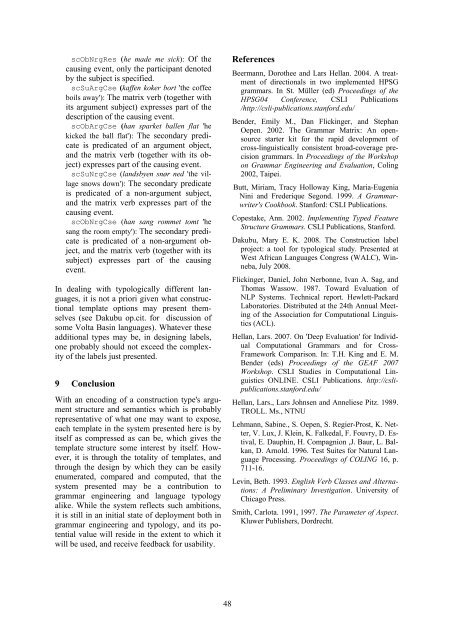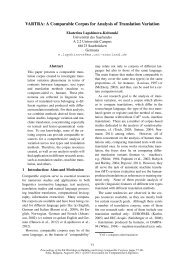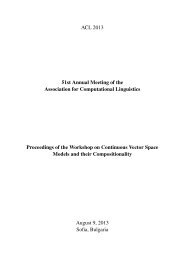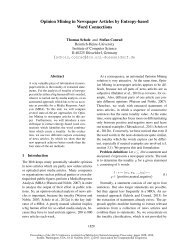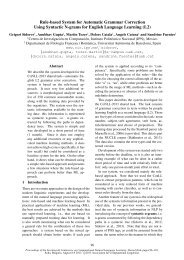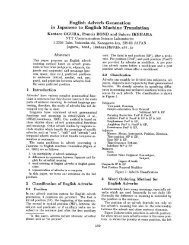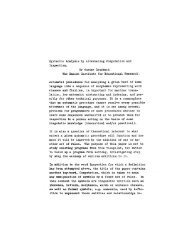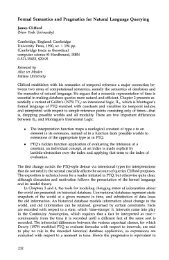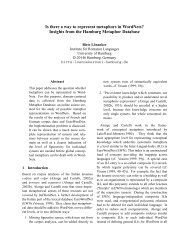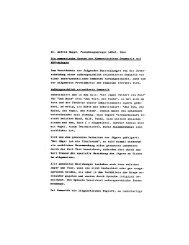From Grammar-Independent Construction Enumeration to Lexical ...
From Grammar-Independent Construction Enumeration to Lexical ...
From Grammar-Independent Construction Enumeration to Lexical ...
You also want an ePaper? Increase the reach of your titles
YUMPU automatically turns print PDFs into web optimized ePapers that Google loves.
scObNrgRes (he made me sick): Of the<br />
causing event, only the participant denoted<br />
by the subject is specified.<br />
scSuArgCse (kaffen koker bort 'the coffee<br />
boils away'): The matrix verb (<strong>to</strong>gether with<br />
its argument subject) expresses part of the<br />
description of the causing event.<br />
scObArgCse (han sparket ballen flat 'he<br />
kicked the ball flat'): The secondary predicate<br />
is predicated of an argument object,<br />
and the matrix verb (<strong>to</strong>gether with its object)<br />
expresses part of the causing event.<br />
scSuNrgCse (landsbyen snør ned 'the village<br />
snows down'): The secondary predicate<br />
is predicated of a non-argument subject,<br />
and the matrix verb expresses part of the<br />
causing event.<br />
scObNrgCse (han sang rommet <strong>to</strong>mt 'he<br />
sang the room empty'): The secondary predicate<br />
is predicated of a non-argument object,<br />
and the matrix verb (<strong>to</strong>gether with its<br />
subject) expresses part of the causing<br />
event.<br />
In dealing with typologically different languages,<br />
it is not a priori given what constructional<br />
template options may present themselves<br />
(see Dakubu op.cit. for discussion of<br />
some Volta Basin languages). Whatever these<br />
additional types may be, in designing labels,<br />
one probably should not exceed the complexity<br />
of the labels just presented.<br />
9 Conclusion<br />
With an encoding of a construction type's argument<br />
structure and semantics which is probably<br />
representative of what one may want <strong>to</strong> expose,<br />
each template in the system presented here is by<br />
itself as compressed as can be, which gives the<br />
template structure some interest by itself. However,<br />
it is through the <strong>to</strong>tality of templates, and<br />
through the design by which they can be easily<br />
enumerated, compared and computed, that the<br />
system presented may be a contribution <strong>to</strong><br />
grammar engineering and language typology<br />
alike. While the system reflects such ambitions,<br />
it is still in an initial state of deployment both in<br />
grammar engineering and typology, and its potential<br />
value will reside in the extent <strong>to</strong> which it<br />
will be used, and receive feedback for usability.<br />
48<br />
References<br />
Beermann, Dorothee and Lars Hellan. 2004. A treatment<br />
of directionals in two implemented HPSG<br />
grammars. In St. Müller (ed) Proceedings of the<br />
HPSG04 Conference, CSLI Publications<br />
/http://csli-publications.stanford.edu/<br />
Bender, Emily M., Dan Flickinger, and Stephan<br />
Oepen. 2002. The <strong>Grammar</strong> Matrix: An opensource<br />
starter kit for the rapid development of<br />
cross-linguistically consistent broad-coverage precision<br />
grammars. In Proceedings of the Workshop<br />
on <strong>Grammar</strong> Engineering and Evaluation, Coling<br />
2002, Taipei.<br />
Butt, Miriam, Tracy Holloway King, Maria-Eugenia<br />
Nini and Frederique Segond. 1999. A <strong>Grammar</strong>writer's<br />
Cookbook. Stanford: CSLI Publications.<br />
Copestake, Ann. 2002. Implementing Typed Feature<br />
Structure <strong>Grammar</strong>s. CSLI Publications, Stanford.<br />
Dakubu, Mary E. K. 2008. The <strong>Construction</strong> label<br />
project: a <strong>to</strong>ol for typological study. Presented at<br />
West African Languages Congress (WALC), Winneba,<br />
July 2008.<br />
Flickinger, Daniel, John Nerbonne, Ivan A. Sag, and<br />
Thomas Wassow. 1987. Toward Evaluation of<br />
NLP Systems. Technical report. Hewlett-Packard<br />
Labora<strong>to</strong>ries. Distributed at the 24th Annual Meeting<br />
of the Association for Computational Linguistics<br />
(ACL).<br />
Hellan, Lars. 2007. On 'Deep Evaluation' for Individual<br />
Computational <strong>Grammar</strong>s and for Cross-<br />
Framework Comparison. In: T.H. King and E. M.<br />
Bender (eds) Proceedings of the GEAF 2007<br />
Workshop. CSLI Studies in Computational Linguistics<br />
ONLINE. CSLI Publications. http://cslipublications.stanford.edu/<br />
Hellan, Lars., Lars Johnsen and Anneliese Pitz. 1989.<br />
TROLL. Ms., NTNU<br />
Lehmann, Sabine., S. Oepen, S. Regier-Prost, K. Netter,<br />
V. Lux, J. Klein, K. Falkedal, F. Fouvry, D. Estival,<br />
E. Dauphin, H. Compagnion ,J. Baur, L. Balkan,<br />
D. Arnold. 1996. Test Suites for Natural Language<br />
Processing. Proceedings of COLING 16, p.<br />
711-16.<br />
Levin, Beth. 1993. English Verb Classes and Alternations:<br />
A Preliminary Investigation. University of<br />
Chicago Press.<br />
Smith, Carlota. 1991, 1997. The Parameter of Aspect.<br />
Kluwer Publishers, Dordrecht.


